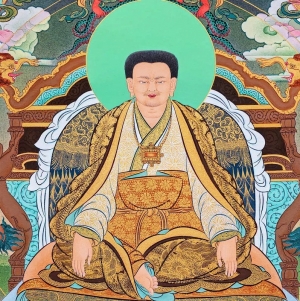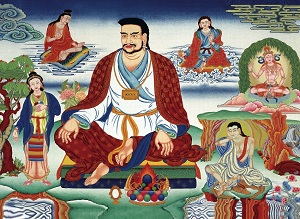Marpa Lotsawa
1. Intro
Marpa Chokyi Lodrö (1012-1097, born as Darma Wangchuk), also known as Marpa Lotsawa (Tibetan: Translator) - was a lama-layman, who brought many Vajrayāna Buddhist teachings to Tibet from India, including teachings on Mahāmudra, which later was the basis for Kagyu lineage of Tibetan Buddhism.
Marpa Darma Wangchuk was born in 1012 in south of Tibet, in a village Pesar in Lhodrak region, in a family of wealthy landowners. If compared to his older brothers, he had a rampant and stubborn temper.
In 1014 he received a Buddhist Refuge and a Buddhist name Chokyi Lodrö. Later he was learning to read and write in the nearest monastery.
But due to his aggressive temper his parents decided to send him to another monastery far from home, in Western Tibet.
There he was learning under the guidance of a well-known translator Drogmi (the founder of the Sakya school) and in course of 3 years learned very well written classical Sanskrit and several Indian spoken dialects.
When he returned home, contrary to his parents’ wishes, he sold his part of heritage with a strong intention to go to India.
2. Marpa's First Travel to India
In Tsi Nesar monastery in Upper Nyang Marpa met another Tibetan-translator Nyo Lotsawa and they together departed to Nepal.
In Nepal Marpa received an initiation in Śrī Chatupithu and teaching about Transferring of Consciousness from Chitherpa, a disciple of the former abbot of Nālanda University and famous Mahāsiddha Nāropa.
In Svayambhūnāth Marpa stayed for 3 years to accommodate himself to Indian climate. When he finally arrived in Nālanda in 1057, Marpa got news that Nāropa has left the University long ago.
However, after a few days Marpa received a message from Nāropa that contained a request to arrive to him to Pullahari in Magadha.
Nyo Lotsawa declined to accompany Marpa.
When Marpa arrived in Pullahari, Nāropa gave him initiation of Hevajra, explained the second part of Hevajra-tantra, Vajrapanjara and Samputa.
After that Nāropa sent him to Jñānagarbha for initiation in Guhyasamāja and then to Kukuripa for Mahāmāyā.
Regarding the discipleship of Marpa, Nāropa, according to tradition has said:
According to predictions of my Guru
My son, Marpa Lodrö – a worthy vessel,
Has arrived from the Land of Snow,
To become my successor.
Later Marpa visited Bengal to prostrate before the statue of Bodhisattva Kasarpani, a form of Bodhisattva Chenrezig with two hands and one face,
and then returned in Nālanda, where compared his knowledge of Buddhist tantra with the knowledge of Nyo, and found how profound were the knowledge he had received.
Then Marpa received Nāropa’s permission to learn from Maitrīpa:
Maitrīpa gave him initiation to Mahāmudra and also commentaries for the text Ārya-Mañjuśrī-nāma-Saṅgīti.
Later again according to recommendation of Nāropa, Marpa received a new initiation in Chatupithu from a yogini of Kusulipa tradition.
Marpa spent altogether 12 years in India and Nepal and spent all his money, so he decided to return in Tibet with intention to travel again as soon he would earn enough funds to do it.
Marpa was returning to Tibet together with Nyo Lotsawa who was envious to him, finding that Marpa was cleverer as him:
Nyo bribed one of his two companions-Paṇḍits so he would throw Marpa’s writings into water when they were crossing the Gang.
Marpa found out it was done by Nyo, but was sceptical regarding his offer to make copies from his book, because teachings received by each one were different.
Later, already in Tibet, Marpa one day approached Nyo with request to lend him his texts, but Nyo turned down his request with an argument that such a wise men as Marpa doesn’t need any written texts.
3. Marpa's Second Journey
In Lhodrak Marpa gave the first initiation to a huge circle of students and together with them was searching for donations for a next trip.
In area Shung one of his disciples was tantra practitioner Ngogdun Chudor, who donated him a large fortune and brought many of his own students to Marpa.
Under the patronage of his relative and disciple Golek, Marpa Chokyi Lodrö was able to collect the required amount.
After this Marpa married with Dagmeme and several other women, and after the birth of his son Tarma Dode, once again went to India.
After his safe arrival in Pullahari and visits to former teachers, Marpa requested Nāropa initiation to Guhyasamāja and commentaries to Buddha-kapala-tantra.
Also in Nāropa’s presence, Marpa translated all received texts of tantras and rituals to Tibetan language.
Before Marpa departed to Tibet, Nāropa noticed him about his intention to transmit him in future also the special teaching about transferring of consciousness.
After 6 years Marpa returned in Tibet.
After returning in Lhodrak, Marpa became a prosperous family man, father of 7 sons and a famous teacher of Buddhist Tantra.
One day, when one of his students, Milarepa, meditating in retreat, had a vision of Ḍākinī, who was speaking about transference of consciousness, he later asked Marpa about it.
Marpa didn’t found anything about it in his writings.
Finally he recalled Nāropa’s wish to meet him once again. And, despite the opposition of his wife and numerous students, who were hiding his travel equipment and food, departed to India.
When Marpa arrived in Sheng, in Upper Nyang, he met Atiśa, who was Nāropa’s friend since times in Nālanda’s University, and received an initiation of Vajramālā from him.
But Marpa declined his invitation to accompany him during his travel throughout Tibet as translator.
In Nepal Marpa got news that Nāropa is preparing to die soon:
He had to hurry up to get a chance to see him again; however, he found Nāropa just 2 years later, in 1069 and again in a forest near Pullahari.
Nāropa gave him teachings and initiations to Hevajra and Cakrasaṁvara.
Here the famous occurrence has taken place:
Nāropa manifested Hevajra and his majestic power-field in front of Marpa and asked – to what would you prostrate first – to Hevajra or to him, his teacher.
Marpa was overwhelmed by the sight of great deity that radiated light and power and bowed down to Hevajra.
Nāropa immediately corrected him, telling the Guru always is first, it is due to Guru that deities, Buddha aspects, become real to us.
After that Marpa returned to Tibet, accompanied by his students, who arrived to Nepal, where Marpa was waiting when the winter would be over.
4. Last years
At the end of his life Marpa became one of most authoritative translators and teachers in Tibet. The best among his disciples were Ngogdun Chudor, Milarepa, Meton Tsenpo and Tshurton Wangi Dorje.
Beloved eldest son of Marpa, the Tarma Dode, died when he fell from a frightened horse.
Marpa Lotsawa died in 1097 at age of 85.

